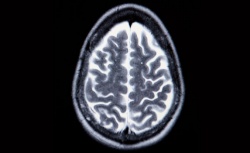Diagnostics
Children: Brain lesions can be challenging to diagnose
Brain lesions in children can be especially challenging to diagnose, according to a report in the journal Frontiers in Neurology by a multidisciplinary team of Loyola University Chicago Stritch School of Medicine physicians. Lesions include tumors, abnormal blood vessel formations, and abscesses and inflammation due to infections.

In the pediatric population, such lesions “can have a large variety of underlying etiologies (causes), which can be challenging to differentiate on neuroimaging,” lead author Marisa McGinley, MD, and colleagues report. The Loyola physicians report the case of a 12-year-old boy who came to his primary care physician with staring episodes. During these episodes, which lasted about one minute, the boy was unresponsive and would make wringing motions with his hands. Afterwards, he would feel tired. His physician put him on an anti-seizure medication.
An MRI showed a lesion in the brain called the left mesial temporal lobe. The boy underwent brain surgery to remove a large portion of the lesion. He recovered well from the surgery, but continued to have occasional seizures. Five years after the surgery, he was having two to three seizures per month, despite taking two anti-seizure medications. In order to get better seizure control, he underwent a second surgery to remove the remaining lesion. His anti-seizure medications gradually were reduced, and three years after the second surgery, he was seizure-free.Pathology from the second surgery showed the lesion was consistent with an arteriovenous malformation (AVM), a tangle of abnormal blood vessels connecting arteries and veins. The AVM likely was present at birth.
The case highlights the challenge in distinguishing different lesions based on imaging, researchers write. MRIs can provide much information about a lesion, and it is important to carefully analyze available imaging to obtain as much information as possible. If diagnosis remains uncertain, it may be helpful to use other imaging techniques, such as PET scans and MR spectroscopy. “Finally, when a diagnosis remains unclear, biopsy needs to be considered, but ultimately it is the entire work-up and clinical picture that will lead to a correct diagnosis,” researchers write.
Dr. McGinley is a resident in the Department of Neurology of Loyola University Chicago Stritch School of Medicine. Co-authors are Jose Biller, MD, and Jorge Asconape, MD, of the Department of Neurology; Haiyan Chen, MD of the Department of Pathology; and Douglas Anderson, MD, of the Department of Neurological Surgery.
Source: Loyola University
03.07.2015











